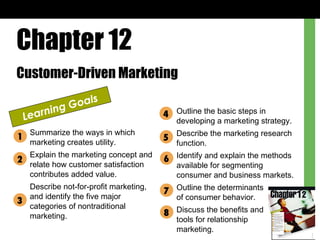
Cb12e basic ppt ch12
- 1. Chapter 12 Customer-Driven Marketing Learning Goals Summarize the ways in which marketing creates utility. Explain the marketing concept and relate how customer satisfaction contributes added value. Describe not-for-profit marketing, and identify the five major categories of nontraditional marketing. Outline the basic steps in developing a marketing strategy. Describe the marketing research function. Identify and explain the methods available for segmenting consumer and business markets. Outline the determinants of consumer behavior. Discuss the benefits and tools for relationship marketing. 1 2 3 4 5 6 7 8
- 2. WHAT IS MARKETING? Marketing Organizational function and set of processes for creating, communicating, and delivering value to customers and for man- aging customer relationships in ways that benefit the organization and its stakeholders. Exchange process Activity in which two or more parties give something of value to each other to satisfy perceived needs. How Marketing Creates Utility Utility Want-satisfying power of a good or service. • Time utility Making a good or service available when customers want to purchase it. • Place utility Making a product available in a location convenient for customers. • Ownership utility Orderly transfer from the seller to the buyer.
- 3. EVOLUTION OF THE MARKETING CONCEPT
- 4. Emergence of the Marketing Concept Marketing concept Company-wide consumer orientation to promote long-run success. • Firm starts with analysis of customers’ needs and works backward to offer products that fulfill them. • Explained by shift from sellers’ market in which goods and services are relatively scarce to buyers’ market in which they are relatively plentiful.
- 5. Delivering Added Value Through Customer Satisfaction and Loyalty • Firm starts with analysis of customers’ needs and works backward to offer products that fulfill them. Customer satisfaction Ability of a good or service to meet or exceed a buyer ’s needs and expectations. • Increasing customer loyalty just five percent equals significant increases in lifetime profits per customer. Customer Satisfaction and Feedback • Can get feedback through toll-free telephone hotlines, customer satisfaction surveys, customer complaints, and other ways.
- 6. EXPANDING MARKETING’S TRADITIONAL BOUNDARIES Not-for-Profit Marketing • 20 million not-for-profits worldwide. • Account for five percent of GDP worldwide. • Apply marketing tools to reach audiences, secure funding, improve their images, and accomplish their overall missions. • Sometimes partner with a profit-seeking company to promote a message.
- 8. DEVELOPING A MARKETING STRATEGY • First, study and analyze potential target markets and choose among them. • Second, create a marketing mix to satisfy the chosen market.
- 9. Selecting a Target Market Target market Group of people toward whom an organization markets its goods, services, or ideas with a strategy designed to satisfy their specific needs and preferences. Marketing mix Blending the four elements of marketing strategy—product, distribution, promotion, and pricing—to satisfy chosen customer segments. Developing a Marketing Mix for International Markets • Standardization Offering the same marketing mix in every market. • Adaptation Developing a unique marketing mix to fit each market’s local competitive conditions, consumer preferences, and government regulations. • Mass customization Firms mass produce goods and services and add unique features to individual or small groups of orders.
- 10. MARKETING RESEARCH Marketing research Collecting and evaluating information to support marketing decision making. Obtaining Marketing Research Data • Use internal and external data. • Secondary data: Previously published data from trade associations, advertising agencies, marketing research firms, and other sources. • Primary data: Data collected through observation, surveys, and other forms of observational study. AC Nielson – Consumer Research
- 11. Applying Marketing Research Data • As accuracy of research information increases, so does the effectiveness of the marketing strategies. • Example: GM’s H3 Hummer research Data Mining Data mining Computer searches of customer data to detect patterns and relationships. • Uses data warehouses , sophisticated customer databases that allow managers to combine data from several different organizational functions. • Example: Walmart’s use to determine local preferences and tailor its inventory appropriately.
- 12. MARKET SEGMENTATION Market segmentation Process of dividing a total market into several relatively homogeneous groups.
- 13. How Market Segmentation Works
- 14. Segmenting Consumer Markets Geographic Segmentation • Divides market into homogeneous groups on the basis of their locations. Demographic Segmentation • Divides market on the basis of various demographic or socioeconomic characteristics. Psychographic Segmentation • Divides consumer market into groups with similar psychological characteristics, values, and lifestyles. Product-Related Segmentation • Divides market based on buyers’ relationship to the good or service. Segmenting Business Markets • Resembles segmentation for consumer markets, but some methods differ.
- 15. CONSUMER BEHAVIOR: DETERMINING WHAT CUSTOMERS WANT Consumer behavior Actions of ultimate consumers directly involved in obtaining, consuming, and disposing of products and the decision processes that precede and follow these actions. Determinants of Consumer Behavior • Personal factors: Needs and motives, perceptions, attitudes, self-concept. • Interpersonal factors: Cultural, social, and family influences. Determinants of Business Buying Behavior • Often a variety of influences from multiple decision makers.
- 16. Steps in the Consumer Behavior Process
- 17. CREATING, MAINTAINING, AND STRENGTHENING MARKETING RELATIONSHIPS Relationship marketing Developing and maintaining long-term, cost-effective exchange relationships with partners. Benefits of Relationship Marketing • Lower costs and higher profits for the business. • Efficient targeting of best customers that increases the lifetime value of a customer . • Stronger relationships with business partners and opportunities to combine capabilities and resources to better accomplish goals.
- 18. Tools for Nurturing Customer Relationships • 80/20 principle: Frequent customers have a higher lifetime value, so businesses allocate resources accordingly. Frequency Marketing and Affinity-Marketing Programs • Frequency marketing Reward purchasers with cash, rebates, and other premiums. • Affinity programs Solicit involvement based on common interest. Example: Credit card with baseball team logo • Comarketing Businesses jointly market each others’ products. • Cobranding Firms link their names in a single product. One-on-One Marketing • Customizing products and marketing and rapidly delivering goods.